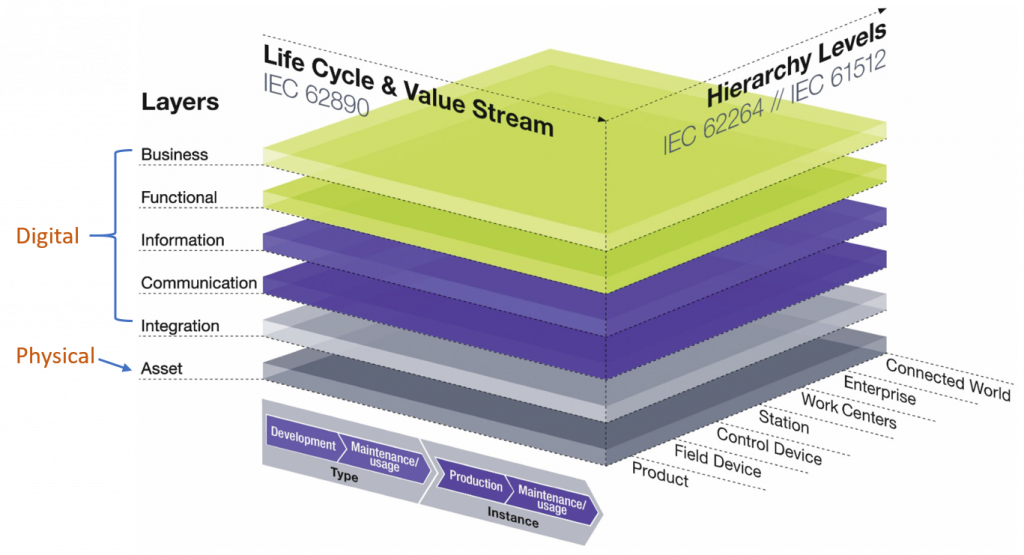Blogautor: Wernher van de Venn
Asset Administration Shell as a Basic Concept for Implementing Industry 4.0
When talking about Industry 4.0 or, better yet, of the broader expression “digitalization in industry”, terms such as cyber-physical systems, digital twin, human-robot collaboration, IoT, augmented reality, big data and many more immediately pop up. Many companies either do not know the term Asset Administration Shell (AAS) at all or consider the AAS to be an unnecessary “academic” overhead for the implementation of Industry 4.0. In fact, the AAS is one of the most underestimated core elements of digitalization, as it is the central concept of Industry 4.0 to enable seamless interoperability. The AAS empowers continuous vertical, horizontal and life cycle integration as it provides a standardized digital description for each asset. This description is not only of static nature but can also reflect the real-time behavior of systems. In this blog we would like to briefly explain and introduce the essential features and advantages of the AAS.
Reference Architecture Model Industry 4.0 (RAMI4.0)
To explain the concept of the AAS, we first have to start with a brief excursion into the Reference Architecture Model for Industry 4.0 (RAMI4.0) in order to understand where the idea of the AAS originates from. RAMI4.0 introduces all elements and IT components in a layer and life cycle model and divides complex processes into simple, manageable packages. RAMI4.0 thus describes how an asset, i.e., a physical object in industrial production, including the product itself, can be converted into a digital representation and processed in the digital world. In other words, RAMI4.0 is the „guide“ for digitalization in industry. RAMI4.0 structures the discussion about assets essentially along the three following „axes“ (Fig. 1):
- Layers: Representation of the information relevant to the role of the asset in the form of the „layers“ Asset, Integration, Communication, Information, Functional and Business.
- Lifecycle: Representation of the lifecycle of an asset separated according to the development of the „type“ and the production of the „instances“ based on IEC 62890.
- Hierarchy: Assignment of functional models of product, field device, control unit, station, technical system, company, networked world, etc. based on the standards DIN EN 62264-1 and DIN EN 61512-1.
As Figure 1 shows, the lowest layer of RAMI4.0 contains the assets, i.e., the physical world, while the layers above describe the digital world. The essential question now is: how to link the physical asset to the digital world and how to achieve the networking of the various hierarchy levels and life cycles across the different layers?

Fig 1.: 3D representation of the Reference Architecture Model Industry 4.0 (RAMI4.0),
Source: DIN SPEC 91345:2016-04 Reference Architecture Model Industry 4.0 (RAMI4.0)
Asset Administration Shell
Now the answer to the question asked above is quite simple: we need a „translator“ which also includes other functions for communication, data provision, ensuring data security, description of the asset property, and so on. You can think of this translator as the digital twin of the physical asset. It practically forms a shell around the real object and, so to speak, encapsulates the physical object in the digital world. This digital representation of the asset is known as the Asset Administration Shell. Together with the asset, the AAS forms the so-called “Industry 4.0 component”. The AAS provides information on Industry 4.0 components, a unique identifier for this asset and a general interface to access the information and functionalities of the asset.

Fig 2.: Asset Administration Shell
Source: ZVEI SG Modelle & Standards
The important point now is, that AAS exist for physical and non-physical units and as a result, devices, products, employees but also processes and software (e.g., ERP, MES) can have asset administration shells and thus become „components“ of Industry 4.0. The power of this approach may be rated low at a first glance, but only with this concept is it possible to do what we have been dreaming of since the advent of industrial production: seamless interoperability between all involved systems. The AAS disburdens from proprietary communication systems, allows continuous communication of all devices from shop floor to management, from supplier to customer and across all product life cycles. It allows new business models, product tracing, predictive maintenance, data access at all levels and unlimited interactivity. The AAS concept is the manufacturer-independent standardization of the description of all industrial components. There are currently no other approaches that provide for such a self-description of systems and devices in a manufacturer-independent manner. The AAS offers a standardized, secure communication interface between the asset and the Industry 4.0 network. In the current version, RAMI4.0 promotes OPC Unified Architecture (OPC UA) as the communication standard.Expanded by the publish / subscribe model and the Ethernet standard Time Sensitive Networking (TSN), OPC UA becomes a real-time communication standard.
There are several open-source activities promoting the AAS, for example, admin-shell (https://github.com/admin-shell-io), BaSyx21 (https://www.eclipse.org/basyx/) and SAP i40-aas (https://github.com/SAP/i40-aas). They provide open-source developer tools such as editors with import and export functionality and software development kits in different programming languages for the AAS. However, it must be mentioned here that these are development versions that are more of an experimental nature and not suitable for industrial deployment.
Benefits, advantages, and opportunities of the AAS concept
It should not be overlooked at this point that the AAS concept generates considerable effort on the development side. You can roughly compare it with a modern computer operating system, but in this case for networked production. However, to stick to this analogy, nobody today would operate a computer without an operating system and accordingly the AAS concept will also offer enormous advantages for production. In the context of this blog, we just want to give a summary listing with the main advantages:
- Reconfigurable Manufacturing Systems (known as Plug & Produce)
- Self-locating, self-organizing production lines Lot size one production
- Customization, order-controlled production
- Scalable, upgradable production lines
- Faster integration, fast ramp-up and ramp-down of production lines
- Bidirectional persisting information flow among manufacturers to integrators to customers
- Fault / lifetime prognosis, predictive maintenance
- New business models
- Efficiency maximization
You are welcome to contact us if you have any questions about the concept, design and implementation of AAS. We work in international committees for the implementation of the AAS and operate an Industry 4.0 demonstrator and a Learning Factory, where we are currently the only institution in Switzerland which is able to show not only the theoretical concepts but also the practical implementation of AAS.
You are welcome to contact us if you have any questions about the concept, design and implementation of AAS. We work in international committees for the implementation of the AAS and operate an Industry 4.0 demonstrator and a Learning Factory, where we are currently the only institution in Switzerland which is able to show not only the theoretical concepts but also the practical implementation of AAS.
Wernher van de Venn

ZHAW Zürcher Hochschule für Angewandte Wissenschaften
School of Engineering
IMS Institute of Mechatronic Systems
Prof. Dr.-Ing. Hans Wernher van de Venn
Director of the Institute of Mechatronic Systems IMS
Adjunct Professor Isfahan University of Technology IUT
Technikumstrasse 5, Postfach
CH-8401 Winterthur / Switzerland
Phone +41 58 934 77 89 Fax +41 58 935 77 89
E-Mail: vhns@zhaw.ch
Internet: https://www.zhaw.ch/de/engineering/institute-zentren/ims/